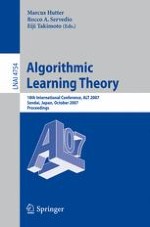This volume contains the papers presented at the 18th International Conf- ence on Algorithmic Learning Theory (ALT 2007), which was held in Sendai (Japan) during October 1–4, 2007. The main objective of the conference was to provide an interdisciplinary forum for high-quality talks with a strong theore- cal background and scienti?c interchange in areas such as query models, on-line learning, inductive inference, algorithmic forecasting, boosting, support vector machines, kernel methods, complexity and learning, reinforcement learning, - supervised learning and grammatical inference. The conference was co-located with the Tenth International Conference on Discovery Science (DS 2007). This volume includes 25 technical contributions that were selected from 50 submissions by the ProgramCommittee. It also contains descriptions of the ?ve invited talks of ALT and DS; longer versions of the DS papers are available in the proceedings of DS 2007. These invited talks were presented to the audience of both conferences in joint sessions.
